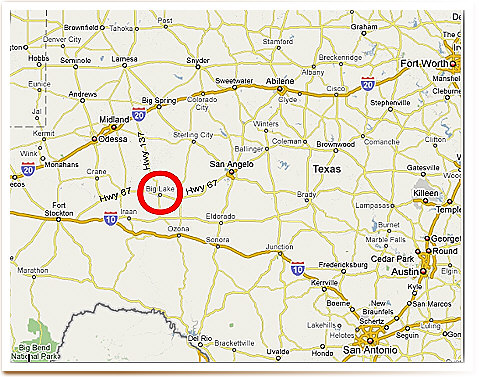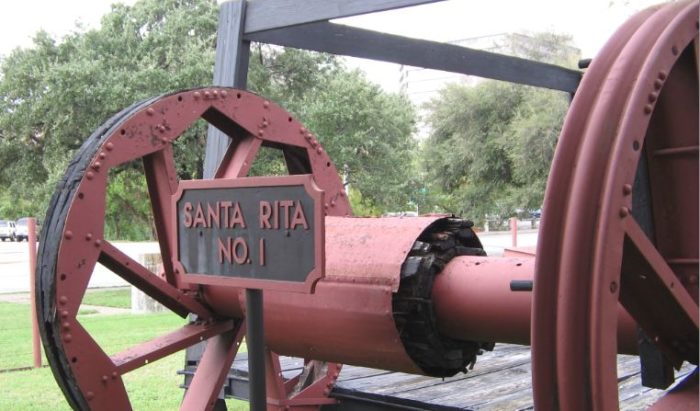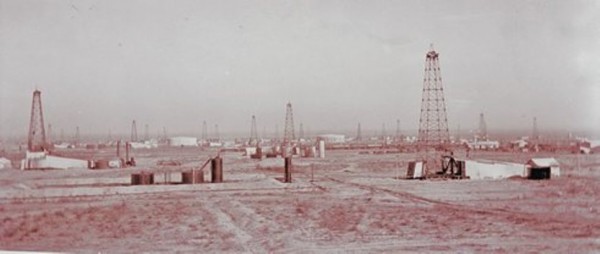This Week in Petroleum History, August 21 to August 27
August 21, 1897 – Olds Motor Vehicle Company founded –
American automotive pioneer Ransom Eli Olds (1864–1950) founded the Olds Motor Vehicle Company in Lansing, Michigan. Renamed Olds Motor Works in 1899, the company became the first auto manufacturer established in Detroit.
By 1901 Olds had built 11 prototype vehicles, including at least one powered by steam, electricity, and gasoline, according to historian George May. “He was the only American automotive pioneer to produce and sell at least one of each mode of automobile.”

Powered by a a single-cylinder, five-horsepower gasoline engine, the 1901 Oldsmobile Curved Dash was the first mass-produced U.S. automobile.
The modern assembly line concept also began with Olds, who used a stationary assembly line (Henry Ford would be the first to use a moving assembly line). Olds Motor Works sold the first mass-produced automobile in 1901, one year after the first U.S. Auto Show.
When the last Oldsmobile rolled off an assembly line in Lansing in 2004, it was the end of America’s oldest automotive brand.
August 24, 1892 – Oil Company founded by Future “Prophet of Spindletop”
Patillo Higgins, who would become known as the “Prophet of Spindletop,” founded the Gladys City Oil, Gas & Manufacturing Company and leased 2,700 acres near Beaumont, Texas. Higgins believed oil-bearing sands could be found four miles south of town. Most earth science experts said he was wrong.
A self-taught geologist, Higgins had noticed oil and natural gas seeps at Spindletop Hill while taking his Sunday school class on picnics. He later supervised the planning of Gladys City, which he named for his favorite student.
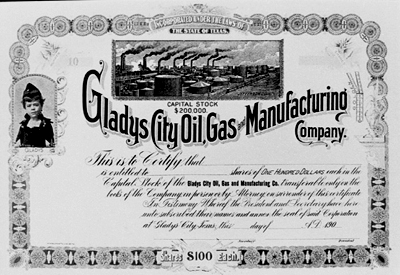
Patillo Higgins was no longer with the company he had founded when it discovered oil at Spindletop Hill in January 1901.
Although Higgins left the Gladys City venture in 1895, Capt. Anthony Lucas drilled the “Lucas Gusher” for the company in January 1901 and forever changed the petroleum industry (the oilfield produced more oil in one day than the rest of the world’s fields combined). Gulf Oil, Texaco, Mobile, and Sun Oil companies got their start thanks to Patillo Higgins’ confidence in the “Big Hill.”
Learn more in Prophet of Spindletop.
August 24, 1923 – University of Texas receives Royalty Check
The University of Texas received the first oil royalty payment ($516.53) three months after the Santa Rita No. 1 well discovered an oilfield on university-owned land in the Permian Basin. After 21 months of difficult drilling, the Texon Oil and Land Company’s well had revealed the 4.5-square-mile Big Lake field.

Drilling and production equipment from the Santa Rita No. 1 well is preserved at the the University of Texas. Photo by Bruce Wells.
Within three years of the Big Lake discovery, petroleum royalties endowed the university with $4 million. In 1958, the university moved the Santa Rita well’s walking beam and other equipment to the Austin campus. A student newspaper described the historic well as “one that made the difference between pine-shack classrooms and modern buildings.”
August 24, 1937 – Music Mountain Oil Discovery
No one had expected it, not even the Niagara Oil Company that drilled it, notes the Bradford Landmark Society about a 1937 gusher near Bradford, Pennsylvania, in McKean County. For the first time since the great Bradford field discovery 70 years earlier, an exploratory well on Music Mountain revealed a new oilfield.

Penn-Brad Museum and Historical Oil Well Park at Custer City, outside Bradford, Pennsylvania, in 2007. Photo by Bruce Wells.
The producing formation was beneath the older, highly prolific Bradford sands. The region’s high-paraffin oil is still considered among the highest grade natural lubricants in the world. A refinery (today’s American Refining Group) has been refining McKean County oil since 1881.
In 2023, Bradford celebrated the 152nd anniversary of its oilfield discovery — and the 52nd anniversary of the opening of its Penn-Brad Oil Museum. Learn more Bradford oil history in Mrs. Alford’s Nitro Factory.
August 26, 2009 – Oil Refinery designated Historic Landmark
The American Chemical Society designated the development of the first U.S. still for refining oil as a National Historic Chemical Landmark in a ceremony in Pittsburgh, Pennsylvania. The society noted that in the 1850s, Samuel Kier constructed a one-barrel, cast-iron still on Seventh Avenue. He began selling distilled petroleum, which he called “carbon oil,” for a $1.50 a gallon.
“Kier’s refining process touched off the search for more dependable sources of crude oil, which led to the drilling of the nation’s first oil well in Titusville, Pennsylvania,” notes a plaque commemorating the achievement. “These two technologies — refining and drilling — made western Pennsylvania the undisputed center of the early oil industry.”
As of January 2022, the United States had 130 petroleum refineries, according to the Energy Information Administration (EIA).
August 27, 1859 – Birth of U.S. Petroleum Industry
America’s petroleum industry began with a well drilled 69.5 feet deep in Titusville, Pennsylvania. Hired by the Seneca Oil Company of New Haven, Connecticut, former railroad conductor Edwin L. Drake drilled the first commercial U.S. oil well. The Venango County well produced 25 barrels of oil a day.
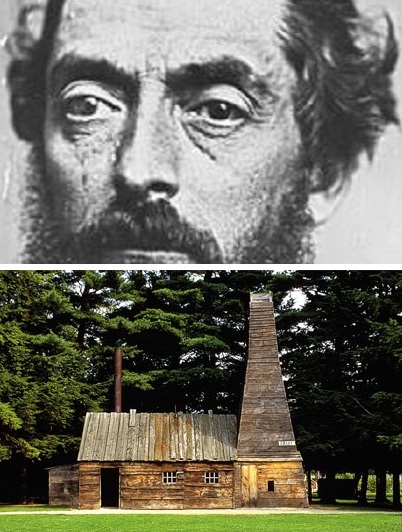
The Drake Well Museum and Park includes a replica of the oil well that forever changed the world.
Although earlier “spring pole” and cable-tool drillers of brine wells had found small amounts of oil – an unwanted byproduct – Drake specifically drilled for it. His investors wanted to refine the oil into a highly demanded new product for lamps, kerosene. Drake also pioneered several new drilling technologies, including a method of driving an iron pipe down to protect the bore’s integrity from nearby Oil Creek.
After five months of financial setbacks and cable-tool drilling problems, the locals called the well “Drake’s Folly.” To improve his reputation, Connecticut investors addressed their letters to “Colonel” Edwin Drake.

Ceiling paintings capture the industry’s earliest scenes inside the Titusville Trust Building, which opened in 1919. A seated Edwin Drake is flanked by men holding cable tools – symbols of early oilfield technology. Photos by Bruce Wells.
Late in the afternoon on August 27, 1859, Drake’s driller, blacksmith “Uncle Billy” Smith, noticed oil floating at the top of the pipe. The bit had reached what would become known as the First Venango Sand. To begin pumping the oil, Drake borrowed a local kitchen water pump.
August 27, 1959 – Stamp celebrates Oil Centennial
“No official act could give me greater pleasure than to dedicate this stamp commemorating the 100th anniversary of the petroleum industry,” declared U.S. Postmaster General Arthur Summerfield, who addressed a crowd gathered for the “Oil Centennial Day” in Titusville, Pennsylvania.
“The American people have great reason to be indebted to this industry,” the Postmaster General added. “It has supplied most of the power that has made the American standard of living possible.”
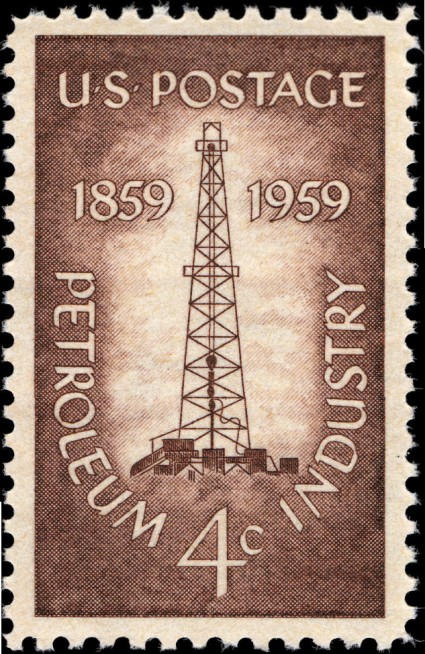
The U.S. Postal Service issued 120 million centennial oil stamps. Efforts for a 2009 anniversary stamp were unsuccessful.
The U.S. Postal Service Stamp Advisory Committee in 2009 rejected requests for a stamp recognizing the 150th anniversary of the U.S. petroleum industry. The committee earlier had granted 10 commemorative stamps for Kermit the Frog and each of his nine fellow Muppets.
Learn more in the Centennial Oil Stamp Issue.
_______________________
Recommended Reading: R.E. Olds: Auto Industry Pioneer (1977); Spindletop: The True Story of the Oil Discovery that Changed the World (1980); Giant Under the Hill: A History of the Spindletop Oil Discovery at Beaumont, Texas, in 1901
(2008); Santa Rita: The University of Texas Oil Discovery
(1958); Myth, Legend, Reality: Edwin Laurentine Drake and the Early Oil Industry
(2009); Black Gold: The Philatelic History of Petroleum
(1995). Your Amazon purchase benefits the American Oil & Gas Historical Society. As an Amazon Associate, AOGHS earns a commission from qualifying purchases.
_______________________
The American Oil & Gas Historical Society (AOGHS) preserves U.S. petroleum history. Become an AOGHS annual supporting member and help maintain this energy education website and expand historical research. For more information, contact bawells@aoghs.org. Copyright © 2023 Bruce A. Wells. All rights reserved.



